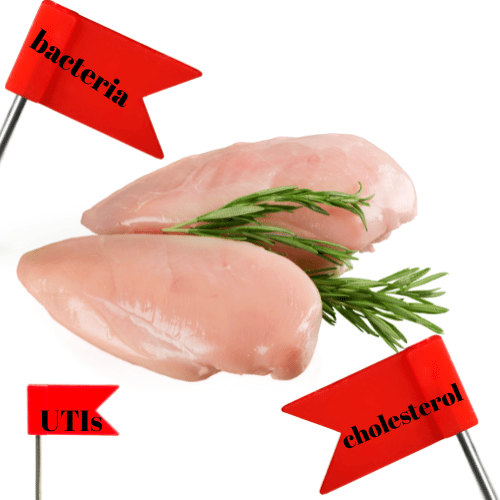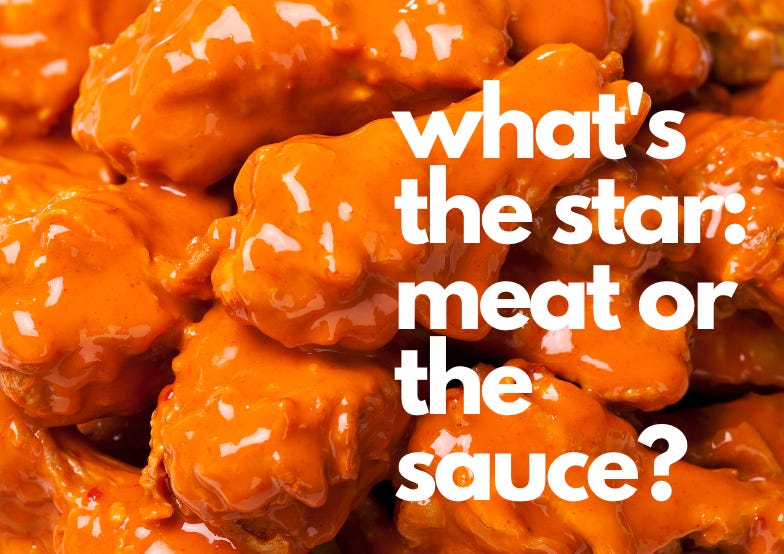With the new year nearly upon us, I figure some are pondering the age-old, often-mocked tradition of making New Year’s Resolutions. Perhaps that’s where Newbtrition comes in, actually. Maybe a mix of broader ideas and easier solutions could team up to make you feel better in 2023 than you felt in 2022? (Even if you insist you feel great?)
As always, though: I’m not an expert, doctor, or nutritionist. Absolutely follow up, do your own research, and discuss bigger lifestyle changes.
Not long ago, I used to chuckle about my childhood belief that pasta is “good for you.” I’m not sure I’m laughing with the same whimsy about thinking that chicken was such a good choice.
My guess is that sort of belief may end up clogging, and maybe stopping, far too many hearts.
That’s because, instead of chicken being a healthy choice, it sure seems like a risky one. As this post goes along, I’ll count down some of the leading reasons why I stay away from chicken, including high rates of cholesterol.
As always, Nutrition Facts.org features a bounty of information on chicken and other things you might eat. It’s recommended that you eat at least some meals without scrolling on your phone or a computer, but if you must (I often must, too), then you could do worse than just to dart around that site’s “topics” section.
If your back is up, if you’re feeling defensive … take it easy.
I’m not trying to convince someone who’s dug-in to believe that meat is unhealthy. No sense trying to force that boulder up an impossibly steep hill. I’ve been on the Internet long enough to basically expect some exhausting person to whittle things down to a semantic battle, leaning on seedy tactics to create the right level of confusion.
And, hey, I giggled at those earnest hippies in the past. I get it. But there was a part of me that wondered if they might be onto something (and about more than the stylishness of moccasins).
So, in 2023, could you give up something big like chicken? Allow me a hot take: you might not even miss it — especially when you realize the possible risks you take with every bite.
Extra especially once you realize that you can eat a wide array of healthy things that also taste really good.
Perhaps by laying out my qualms with chicken, you may agree with me that the risks outweigh the rewards. At worst, maybe down the line you at least realize that, when you’re eating meat, you’re making a number of gambles.
Maybe it doesn’t matter where chicken ranks in the dangerous meats power rankings
As time goes on, I’ll probably go in deeper on my broader concerns with all types of meat. The simple version, though, is that I think a lot of people believe that chicken is healthy mainly because of how often it’s compared to even worse meat.
But are those other meats even worse? If you’re like me, the warning signs stacked so high that I felt like I wasted time trying to figure that out. They all seem bad enough.
It is kind of wild to see chicken hang with some of the biggest baddies, though.
Need more specifics to chew on? Let’s examine red flags like someone mulling over eating the wings or the breast.
Troubling cholesterol
Check out this Heathline story that compares the cholesterol levels of a few types of chicken vs. other meats like steak. This infographic captures the disturbing comparison, and is probably charitable, as the serving sizes are at just 3.5 ounces:

Ummm, yikes.
Less saturated fat is nice, but those cholesterol numbers are disturbing. By the way: anyone creating confusion regarding whether cholesterol is bad or not is trying to confuse you, and maybe sell ya some meat.
Kind of a high failure rate, captain
Chicken is big business. Why let horrifying bacteria slow down the ‘ol gears of progress (just wipe down the wheels, or someone could get sick).
Here’s a fun stat about how chicken-hawkers are legislated, via Consumer Reports in 2021:
The USDA, in fact, allows 9.8 percent of the whole chickens it tests to be contaminated with salmonella. The percentages are even higher for chicken parts (15.4 percent) and ground chicken (25 percent). Campylobacter, too, is allowed in poultry—15.7 percent of samples for whole chickens, 7.7 percent for parts, and 1.9 percent for ground.
Essentially, the USDA allows as many diseased chickens to enter the food supply as a middling backup NHL goalie allows pucks to hit their net. Cool!
Seeing all the cute little critters living (and dying) in terrible conditions may only register with some people. But those lousy, filthy conditions and the sheer size of the meat-making machine should also make your practical side tingle.
That Consumer Reports article notes that salmonella and campylobacter account for approximately 1.9 million illnesses, 28,000 hospitalizations, and 450 deaths per year. (FWIW: Dealing with food poisoning is no joke, even if you avoid being hospitalized.)
Even if you burn the bacteria off of your chicken, you may still be eating some Frankenbird pumped full of antibiotics and who-knows-what. And, even if you avoid all of those pitfalls, there’s still that worrying level of cholesterol to consider.
With chicken, you can run into fun debates, such as “is this dangerous enough to be classified as a carcinogen like red meat, or is it not quite the bad?”
There also appear to be links between chicken and UTIs. Sheesh.
A sneaky source of sodium?
As I’ve discussed before, the sodium content of chicken can feel like a moving target. The most irritating tactic is “plumping,” where chicken-hawkers inject sodium into chicken to add weight, and thus make more money.
But even if that gets legislated into the past, it’s a beacon to pay attention. When you go out to eat, you may want to assume that your chicken has been bombarded with sodium.
That’s one of the big reasons why I highly recommend researching your options if you know where you’re going to eat (or know that you’ll be back):
Is ‘tastes like chicken’ really much of a compliment?
Think about it.
When someone says something “tastes like chicken,” they generally mean that it’s inoffensive. They’re reassuring you that, maybe the roof isn’t so high, but the floor is palatable enough.
In more oblivious times, that might be a relief. But when you start to weigh the risks, why gamble on basically eating a blank, heart-clogging slate? Are you that much of a texture hound?
Think about your favorite chicken dishes. Deep down, ask yourself: how often is it really just about the breading, seasoning, or sauce?
Chicken nuggets: complaining about chicken nuggets having soy filler is pretty comical. How many people would pass a blind taste test, especially if they use chicken nuggets as a sauce-to-mouth device anyway?
Buffalo wings: it’s all about the the sauce, and it all being fried to the right texture. When they’re “boneless buffalo wings,” it’s the sauce and the breading.
Fried chicken: all of that grease, and super-secret herbs and spices that are definitely not “mainly salt and pepper.”
Cajun chicken: I think you catch the drift.
Even rotisserie chicken recipes lean on butter.
Solid alternatives, especially for stuff that’s barely about the chicken anyway
Confession time: once I decided to drop meat, I wasn’t going on an endless journey to find things that were like meat. Between mammoth salads …
… and a nutrition-packed shake each day, I generally check a lot of boxes without hurting the brain too much.
But, sure, my wife and I would be delighted to eventually concoct our own healthy versions of buffalo wings, blackened chicken, and so on. Right now, the “newb” part of Newbtrition is glaring especially bright in this area.
So, the journey’s just begun.
I have, however, dipped my toes in the Beyond/Impossible/pricey smaller freezer section options. The two big takeaways are:
They aren’t perfect replacements, especially when you get beyond stuff that’s basically mystery meat anyway (like chicken nuggets or sausage).
These options have drawbacks, too. You should look at them as a “bridge” from hazardous meat to ideal options, rather than the dietary destination.
In all honesty, I’d dig deeper for a better option than this spicy “chick’n” filet, but it captures some of the drawbacks (especially the 900mg of sodium) and the advantages (zero cholesterol, 24g of protein, hopefully tastes close to the real thing) of these faux-meats.
(This spicy black bean burger patty is an example of something I’d actually buy and eat.)
My advice is to pour over ingredients lists, and try to identify the pros and cons. This is especially viable when you’re at home, rather than at a grocery store with someone getting annoyed that you’re hogging the healthy-ish frozen food freezer. If you’re needing to scan more quickly, emphasize these nutrition facts:
Do your best to avoid any trans fat. Keeping the saturated fat moderate is important, too.
Limit sodium. Most of the faux-meat stuff I get is 600mg of sodium or (ideally) quite a bit less. Remember: sauces, sides, and even bread can really start to stack the deck.
Preferably zero or at least low cholesterol. A big part of the point is to get meat-range protein without clogging your arteries.
No or low added sugar. Gotta pay attention to the details.
High or some Fiber. The linked example is weak in that area, but some of the fake meats use the sort of plant-based goodness that will add fiber to the mix. Laugh about doodoo all you want; fiber is about more than regularity, as you can see from these big benefits, including possibly lowering your risk of heart disease and some types of cancer. Most immediately, you’ll feel fuller after a meal with both protein and fiber, instead of just protein.
Yes, it’s good to track calories, as long as they aren’t your sole focus. And sometimes such a focus can lead you astray. Nuts are calorie-dense, yet they bring a lot to the table. Sometimes a “light” food makes up for lost calories by loading up on salt.
Maybe you disagree, or maybe you just need time
Maybe some of this stuff is obvious to certain readers. This post is for people who assumed that something like grilled chicken is basically a no-brainer. Instead, you likely need to really weigh your thoughts, asking if chicken is truly the thing you should eat.
Just remember: the stakes aren’t as high as you might assume. Haven’t you heard that a lot of other things taste like chicken?






